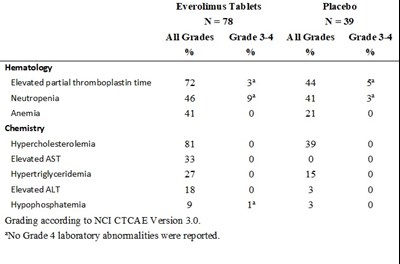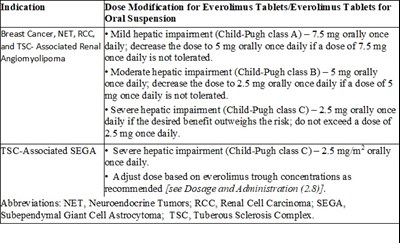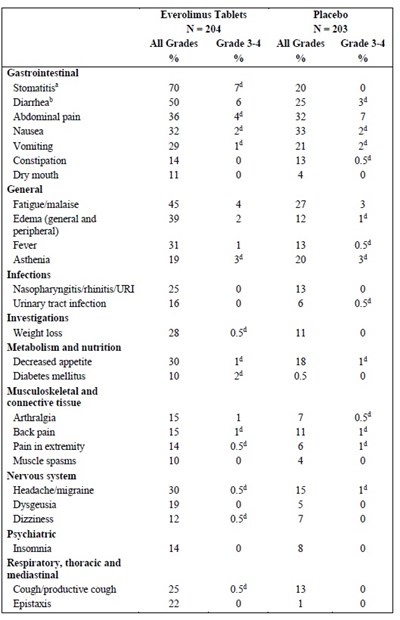Product Images Everolimus
View Photos of Packaging, Labels & Appearance
- carton-1 - everolimus 2mg carton
- foil-1 - everolimus 2mg foil
- carton-2 - everolimus 3mg carton
- foil-1 - everolimus 3mg foil
- carton-3 - everolimus 5mg carton
- carton-5 - everolimus 5mg foil
- figure-1 - everolimus figure 1
- figure-2 - everolimus figure 2
- figure-4 - everolimus figure 4
- image-1 - everolimus image 1
- image-2 - everolimus image 2
- image-3 - everolimus image 3
- table-1 - everolimus table 1
- table-10 - everolimus table 10
- table-11 - everolimus table 11
- table-12 - everolimus table 12
- table-13 - everolimus table 13
- table-14 - everolimus table 14
- table-15 - everolimus table 15
- table-16 - everolimus table 16
- table-17 - everolimus table 17
- table-2 - everolimus table 2 2part
- table-2 - everolimus table 2
- table-20 - everolimus table 20
- table-21 - everolimus table 21
- table-22 - everolimus table 22
- table - everolimus table 23
- table-24 - everolimus table 24
- table-25 - everolimus table 25
- table-3 - everolimus table 3
- table-4 - everolimus table 4
- table-5 - everolimus table 5
- table-6 - everolimus table 6 2part
- table-6 - everolimus table 6
- table-7 - everolimus table 7
- table-8 - everolimus table 8 2part
- table-8 - everolimus table 8
- table-9 - everolimus table 9
Product Label Images
The following 38 images provide visual information about the product associated with Everolimus NDC 63850-0130 by Natco Pharma Limited, such as packaging, labeling, and the appearance of the drug itself. This resource could be helpful for medical professionals, pharmacists, and patients seeking to verify medication information and ensure they have the correct product.
carton-1 - everolimus 2mg carton

Each tablet contains 2mg everolimus for oral use. The package includes instructions for dosage information. Store at a temperature between 20°C to 25°C (68 to 77°F) with excursions permitted between 15°C and 30°C (59°F and 86°F). The tablets must be dispersed in water and not swallowed whole, chewed, or crushed. It is important to keep the medication out of reach of children. This product is manufactured by Netco Pharma Limited in Visakhapatnam, India.*
carton-2 - everolimus 3mg carton

Each tablet contains 3 mg of Everolimus for oral use. The tablets must be dispersed in water and should not be swallowed whole, chewed, or crushed. The storage conditions recommended are between 20°C to 25°C (68°F to 77°F), with excursions permitted between 15°C to 30°C (59°F to 86°F). The product is manufactured by Natco Pharma Limited in India. The packaging includes 26 tablets for oral suspension, with each tablet containing 3 mg of Everolimus. Remember to keep this and all drugs out of the reach of children.*
carton-3 - everolimus 5mg carton

Each tablet contains 5 mg of everolimus for oral use. It is important to refer to the package insert or dosage information for proper usage. The tablets must be dispersed in water and should not be swallowed whole, chewed, or crushed. The recommended storage temperature is between 20°C to 25°C (68°F to 77°F), with excursions permitted between 15°C to 30°C (59°F to 86°F). These instructions are for Everolimus Tablets for Oral Suspension manufactured by Natco Pharma Limited in India. The package contains 28 tablets for oral suspension, with each blister card containing 7 tablets.*
table-1 - everolimus table 1

This text provides guidelines on when to assess trough concentrations after different events related to the administration of everolimus tablets or oral suspension. These events include initiation, modification of dose, switching between formulations, starting or stopping inhibitors/inducers, changes in hepatic function, and stable dose adjustments based on body surface area. The suggested timing for assessment ranges from 1 to 2 weeks to every 6 to 12 months based on the specific event. The text also includes an abbreviation explanation for P-glycoprotein (P-gp).*
table-11 - everolimus table 11

This text provides information on the side effects of Everolimus tablets compared to a placebo. The table includes data on hematological and biochemical abnormalities observed during the study. The grading is done according to the National Cancer Institute Common Terminology Criteria for Adverse Events (NCI CTCAE) Version 4.03. Some of the observed abnormalities include anemia, lymphopenia, leukopenia, thrombocytopenia, hypercholesterolemia, hyperglycemia, and hypokalemia. The text indicates that no Grade 4 laboratory abnormalities were reported during the study.*
table-12 - everolimus table 12

This text presents data on the adverse effects observed in a clinical trial involving Everolimus tablets. Adverse reactions are categorized by their impact on different body systems such as gastrointestinal, general, respiratory, skin, metabolism, nervous system, and musculoskeletal. Common adverse reactions include diarrhea, nausea, fatigue, rash, and headache. The information also highlights the grading system used and specific definitions for certain reactions like stomatitis and pneumonitis. It is essential to consult medical professionals for a comprehensive understanding of the implications.*
table-13 - everolimus table 13

This table displays the laboratory parameters of Everolimus Tablets compared to Placebo in a study with 274 and 137 participants, respectively. The data includes hematological parameters such as anemia, lymphopenia, thrombocytopenia, and neutropenia, as well as chemistry parameters like hypercholesterolemia, hypertriglyceridemia, hyperglycemia, and more. Grading was done according to NCI CTCAE Version 3.0, and it notes that no Grade 4 laboratory abnormalities were reported.*
table-14 - everolimus table 14

This is a comparison of the side effects observed in patients taking Everolimus tablets versus a placebo. The table shows the percentage of patients experiencing different types of side effects such as gastrointestinal issues, infections, musculoskeletal problems, respiratory symptoms, and skin conditions. It is noted that no Grade 4 adverse reactions were reported in this study. Side effects include stomatitis, vomiting, diarrhea, peripheral edema, upper respiratory tract infections, arthralgia, cough, and acne. The grading is based on NCI CTCAE Version 3.0.*
table-15 - everolimus table 15

This document provides a comparison between the incidence of various adverse effects in a study comparing Everolimus tablets to a placebo. The table shows the percentages of patients experiencing different hematological and biochemical abnormalities, including anemia, leukopenia, hypercholesterolemia, and others. The grading is based on the NCI CTCAE Version 3.0, and it notes that no Grade 4 laboratory abnormalities were reported during the study.*
table-16 - everolimus table 16

This text presents a summary of adverse reactions reported in a clinical study comparing Everolimus tablets with placebo. The table shows the percentage of patients experiencing various side effects categorized by organ system and includes gastrointestinal issues, infections, general symptoms like fever and fatigue, psychiatric effects such as anxiety and aggression, and skin-related problems. The grading is based on the NCI CTCAE Version 3.0 criteria. The text clarifies the content of certain categories like stomatitis and respiratory infections. It also mentions that no Grade 4 adverse reactions were reported in the study.*
table-17 - everolimus table 17

This is a comparison of the side effects between Everolimus tablets and Placebo in a study involving 78 participants for Everolimus and 39 for Placebo. The table shows the percentages of different hematological and biochemical abnormalities observed in the participants. These abnormalities include elevated partial thromboplastin time, neutropenia, anemia, hypercholesterolemia, hypertriglyceridemia, elevated AST and ALT levels, and hypophosphatemia. The grading is done according to NCI CTCAE Version 3.0, and it is noted that no Grade 4 laboratory abnormalities were reported.*
table-2 - everolimus table 2 2part

This text provides guidelines for managing Neutropenia, specifically regarding dose adjustments based on the severity of the condition (Grade 3 or Grade 4). It includes instructions on when to withhold medication, when to resume at the same dose or at a reduced dose, and when to permanently discontinue if necessary. Precautions and considerations for febrile neutropenia are also mentioned.*
table-2 - everolimus table 2

This text provides dosage modification guidelines for handling adverse reactions of varying severity in patients. It includes instructions for conditions such as pneumonitis, stomatitis, metabolic events like hyperglycemia, dyslipidemia, and other non-hematologic toxicities. The guidelines suggest withholding treatment until improvement to Grade 0 or 1, resuming at reduced doses, changing to every other day dosing if necessary, and permanently discontinuing if needed. It also addresses thrombocytopenia and offers specific steps to follow based on the grade of the adverse reaction.*
table-20 - everolimus table 20

This text provides a comparison between Everolimus and Placebo in combination with Exemestane, focusing on factors such as progression-free survival, radiological review results, and objective response rate. The data includes hazard ratio, p-values, and other statistical information derived from clinical trials involving a total of 724 participants. The analysis indicates a significant difference in outcomes between the two treatment regimens.*
table-21 - everolimus table 21

This text provides an analysis comparing the efficacy of Everolimus versus a placebo in terms of progression-free survival. The study involved a total of 203 patients who received Everolimus tablets and 207 patients who received a placebo. The analysis shows the median progression-free survival in months along with hazard ratios and p-values. The results were evaluated through investigator radiological review, central radiological review, and adjudicated radiological review to ensure accuracy and consistency in the assessments. The data indicates a significant difference between the two groups, with Everolimus demonstrating a more favorable outcome compared to the placebo.*
table-22 - everolimus table 22

This is a comparative analysis between Everolimus tablets and Placebo. It includes data on Progression-Free Survival, Number of Events such as Progressive Disease and Death, as well as Median PFS in months. The Hazard Ratio and p-value related to Overall Response Rate are also given. The results show a significant difference in outcomes between the two groups.*
table - everolimus table 23

This text provides information about a study comparing Everolimus and Placebo in tablets for a group of 130 participants. The study showed a significant difference in progression-free and overall survival between the two groups, with a hazard ratio of 0.33 and a p-value of 0.0001. The median progression-free survival was 79 months, and there was a difference in response rates between the two groups. The analysis was done using a log-rank test stratified by prognostic score. The text also mentions that some information is not applicable in this context.*
table-24 - everolimus table 24

This is a summary of a study involving Everolimus tablets in the treatment of Angiomyolipoma, a rare tumor usually found in the kidney. The study included 79 participants, with a primary analysis showing a response rate of 41.8% (95% CI: 30.8-53.4) according to an independent central radiology review. The p-value calculated for this response rate was found to be less than 0.0001, indicating a significant impact of Everolimus tablets on treating Angiomyolipoma.*
table-25 - everolimus table 25

This is a statistical analysis report for Everolimus tablets involving 78 participants. The primary analysis included the response rate for SEGA, which was 35%. The 95% confidence interval for the response rate was between 24% and 46%. The independent central radiology review had been conducted for the analysis. The p-value obtained was less than 0.0001, indicating statistical significance.*
table-3 - everolimus table 3

Dosage modification guidelines for Everolimus in various conditions and hepatic impairment levels are provided. The text outlines specific doses for Breast Cancer, Neuroendocrine Tumors, Renal Cell Carcinoma, TSC-Associated Renal Angiomyolipoma, and SEGA based on the severity of hepatic impairment. It also suggests adjusting the dose according to everolimus trough concentrations. Additionally, certain medical abbreviations like NET, RCC, SEGA, and TSC are clarified for better understanding.*
table-4 - everolimus table 4

This text provides dose modification instructions for Everolimus tablets and suspension in the treatment of Breast Cancer, NET, RCC, TSC-associated Renal Angiomyolipoma, and TSC-Associated SEGA. It advises reducing the dose to 2.5 mg once daily, with the possibility of increasing to 5 mg once daily if tolerated. It also outlines steps for resuming the initial dose after discontinuing the inhibitor for 3 days, as well as adjusting the dose based on tolerability and trough concentrations. It's essential to follow these guidelines for effective treatment.*
table-5 - everolimus table 5

This information details the indication for Everolimus Tablets in treating conditions such as breast cancer, NET, RCC, TSC-associated renal angiomyolipoma, and TSC-associated SEGA. It provides guidance on dose modifications, including recommendations when coadministering with other medications and when discontinuing inducers. Trough concentrations should be assessed when initiating and discontinuing the inducer. Dosage adjustments may involve doubling the daily dose using increments of 5 mg or less, and multiple increments may be necessary. Resuming the original dose after discontinuing inducers for 5 days is advised.*
table-6 - everolimus table 6 2part

This document provides information on various side effects related to a drug or treatment, classified by the affected body system. It includes details on symptoms such as dysgeusia, headache, insomnia, cough, dyspnea, epistaxis, pneumonitis, rash, pruritus, alopecia, and hot flushes. The grading is done according to NCI CTCAE Version 3.0. Adverse reactions mentioned in the text encompass mouth issues, infections (urinary tract, respiratory tract, skin, gastrointestinal), and lung complications. Overall, no Grade 4 adverse reactions were reported.*
table-7 - everolimus table 7

This is a description of the laboratory results from a study involving Everolimus tablets with a placebo and Exemestane. The table shows various parameters such as hematological and biochemical values for Exemestane in a study sample of 482 individuals. The data includes information on grades of adverse events like anemia, leukopenia, thrombocytopenia, lymphopenia, neutropenia, as well as chemistry-related abnormalities like hypercholesterolemia, hyperglycemia, abnormal liver enzymes, hypertriglyceridemia, hypoalbuminemia, and others. The grading is based on the NCI CTCAE Version 3.0, and it's noted that there were no Grade 4 laboratory abnormalities reported.*
table-8 - everolimus table 8 2part

This text provides a list of potential adverse reactions or side effects, along with their corresponding grades according to the NCI CTCAE Version 3.0. The side effects mentioned include dyspnea, pneumonitis, oropharyngeal pain, skin rash, nail disorders, pruritus, dry skin, and hypertension. It also offers additional information on the grading criteria for specific reactions like stomatitis, diarrhea, and pneumonitis. Additionally, it notes that no Grade 4 adverse reactions were reported.*
table-8 - everolimus table 8

This text appears to be a list of side effects associated with Everolimus tablets across different grades. It includes a range of symptoms grouped under different categories such as Gastrontestinal, General, Infections, Investigations, Metabolism and Nutrition, Musculoskeletal, Nervous System, Psychiatric, and Respiratory. Some common side effects mentioned are stomatitis, diarrhea, abdominal pain, nausea, vomiting, fatigue, edema, fever, arthralgia, headache, cough, and insomnia. These side effects are categorized based on their occurrence percentages in different grade levels.*
table-9 - everolimus table 9

This dataset shows laboratory parameters for Everolimus tablets compared to Placebo in a study with N=204 for Everolimus and N=203 for Placebo. It includes hematological and biochemical measurements such as anemia, lymphopenia, thrombocytopenia, leukopenia, neutropenia, hyperglycemia, alkaline phosphatase levels, hypercholesterolemia, hypophosphatemia, hypertriglyceridemia, and more. Grading was done according to NCI CTCAE Version 3.0.*
* The product label images have been analyzed using a combination of traditional computing and machine learning techniques. It should be noted that the descriptions provided may not be entirely accurate as they are experimental in nature. Use the information in this page at your own discretion and risk.










